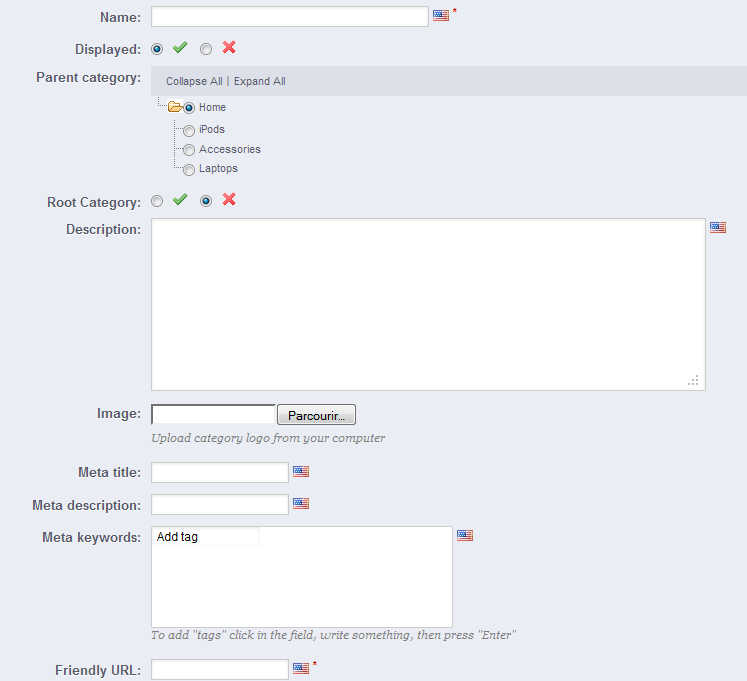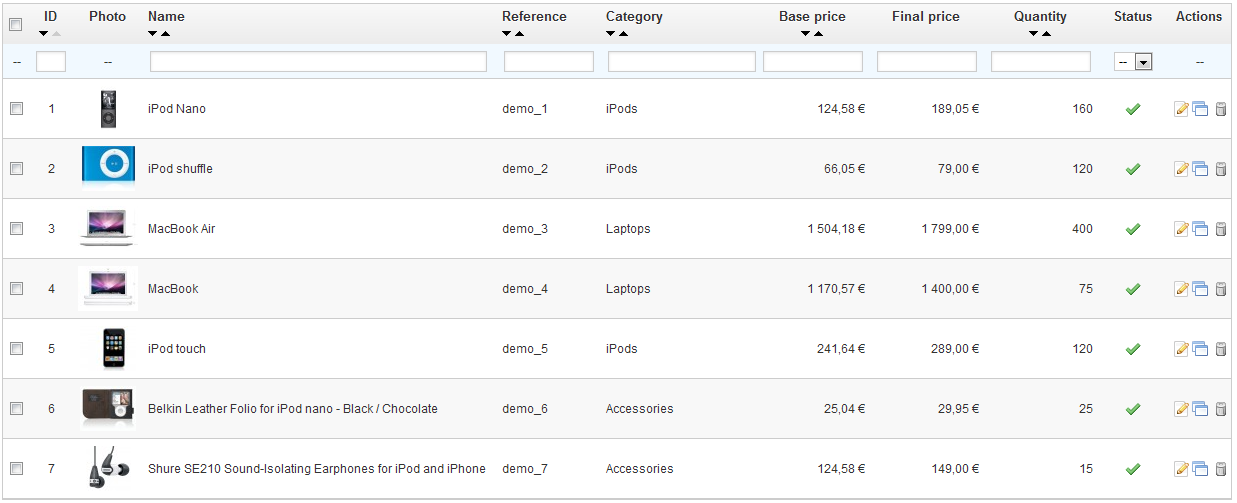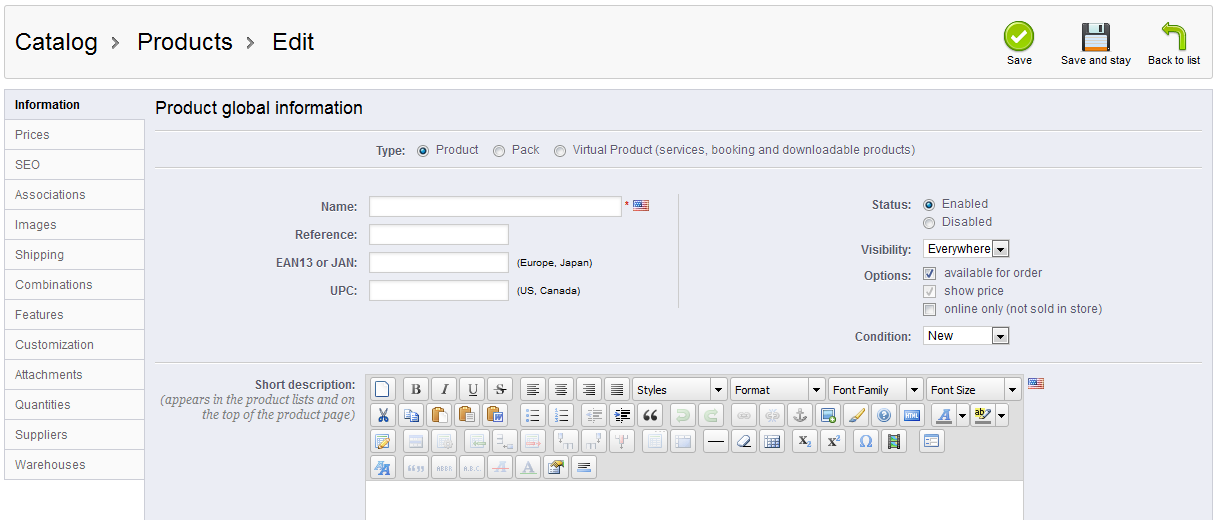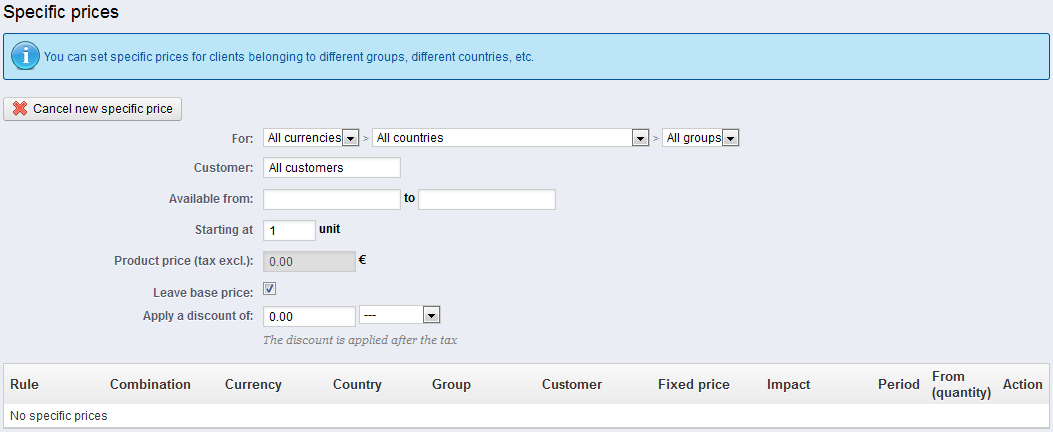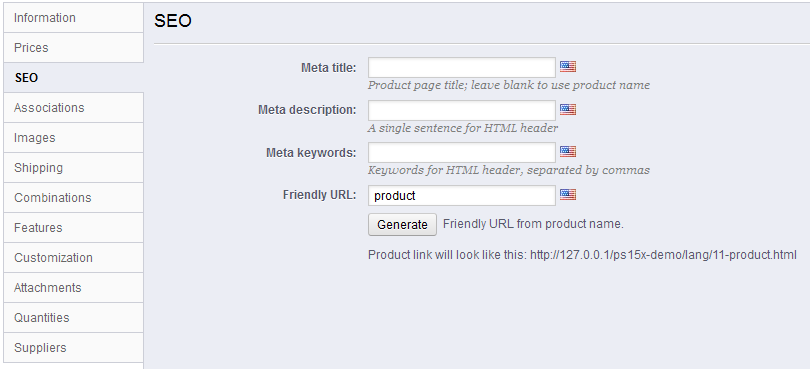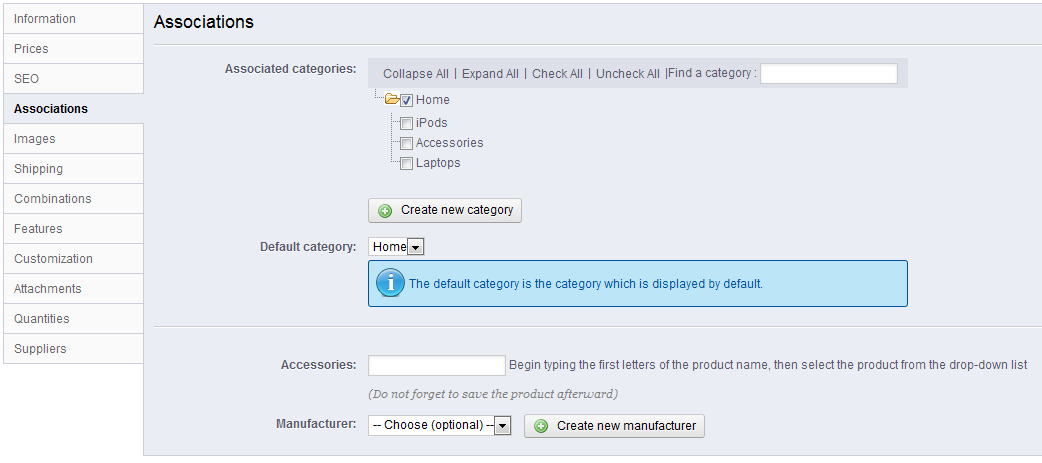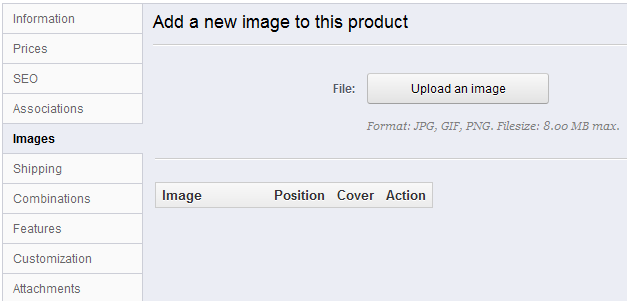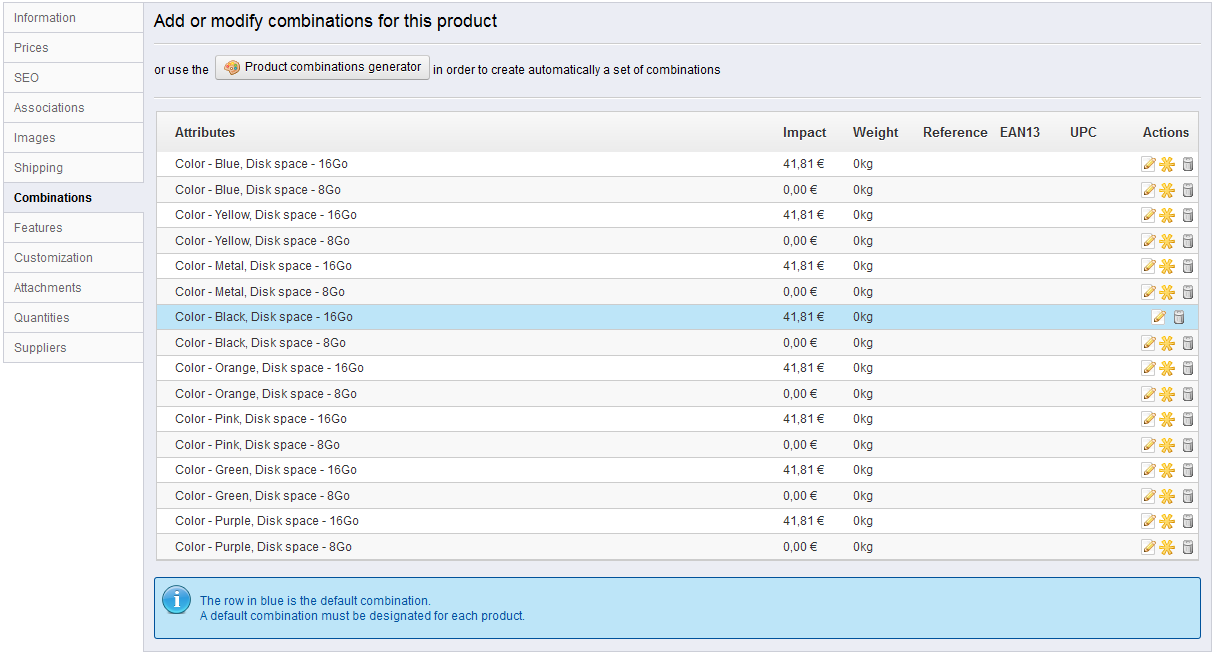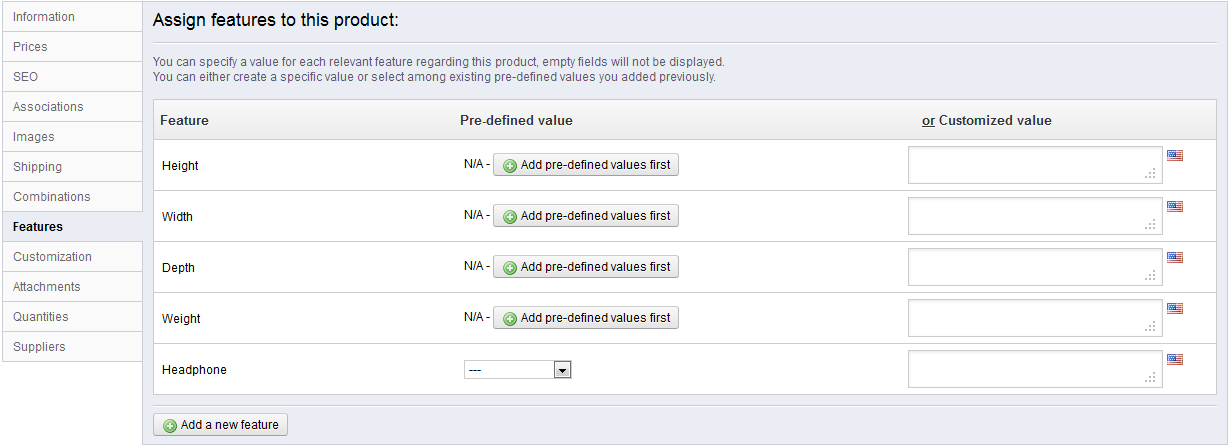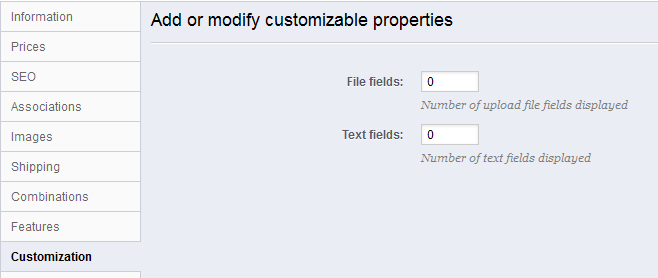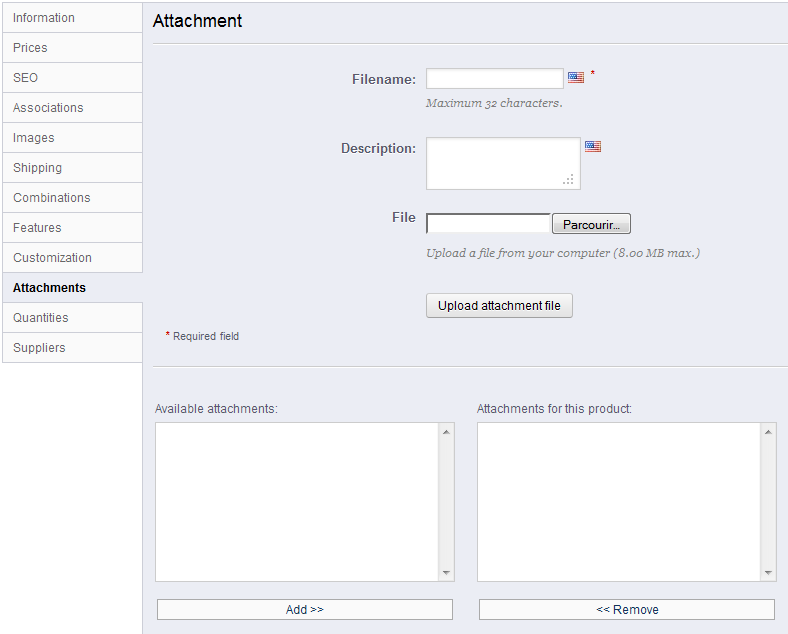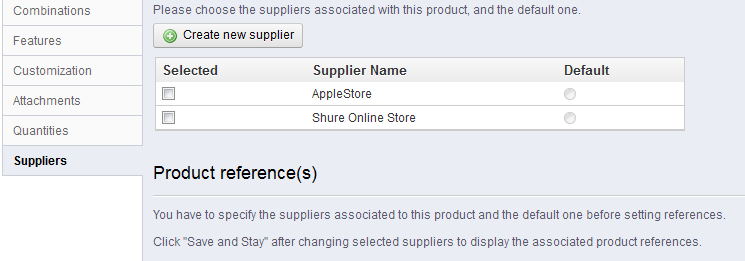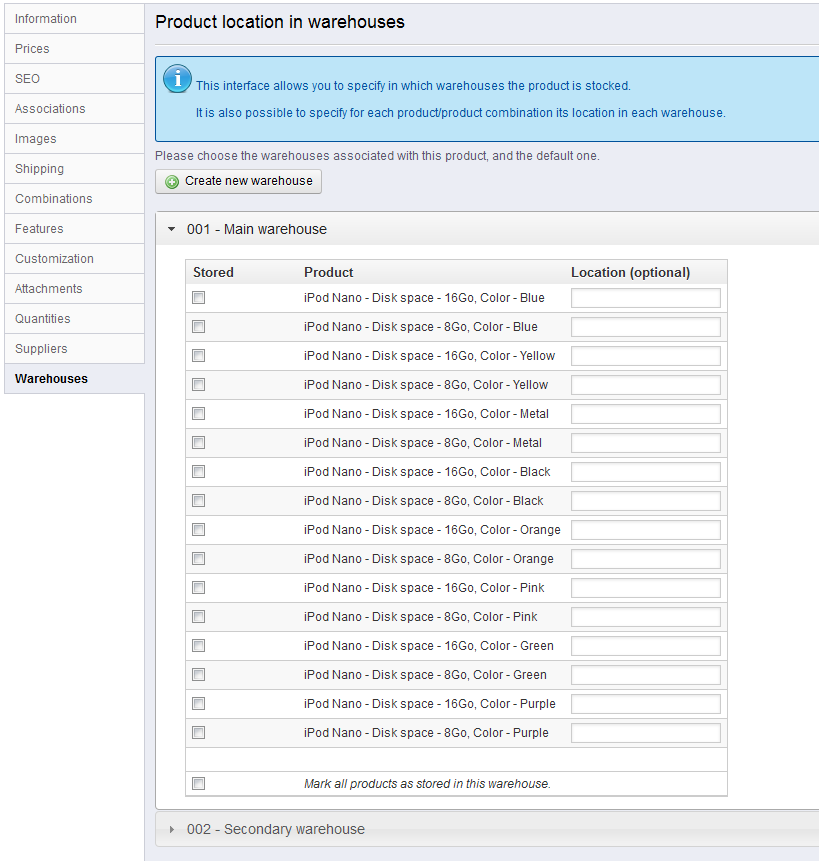...
Categories are managed in the "Categories" page of the "Catalog" menu.
To create a category, click on the "Add new" button and fill out the form.
| Tip |
|---|
Make sure to fill each field in every language that your shop supports. In order to do that, click on the little flag next to the field, choose the flag of the language in which you wish to edit the text. |
...
You can manage the products in your shop using the "Products" page, in the "Catalog" menu. You can see the existing products and few details.
You can add new products by clicking on "Add new". A form appears, with several tabs in the left column.
...
- Save. This saves any change you have made to any of the data for the current product, and takes you back to the product list.
- Save and stay. This saves any change you have made to any of the data for the current product, and keeps you on the current tab. This is particularly useful when you want to switch tabs without losing your changes to the current tab, or seeing your changes get applied immediately.
- Back to list. It simply takes you back to the list of product, without saving any change you have made in any of the tab from this page.
As soon as you save your product, using either the "Save" or the "Save and stay" button, more buttons appear:
- Delete this product. Removes all the data for the current, including its images, combinations, features, etc.
- Duplicate. Creates an exact copy of the current product. This is very useful when you'd rather use the current product's data as a template for another new product, and not have to create every data of the new product by hand. For instance, two products might be very different, but could share the same associations, carriers or supplier settings.
Note: if you need to create different versions of the same product, because of its variety of colors, capacity, size, etc., then you should create product combination for the current product rather than duplicating it X times. See the "Combinations" tab on the left, which is explained in the "Adding Product Combinations" section of this chapter. - Preview. Displays the front-page page of your product. This is very handy, as it works even if the product is disabled ("Informations" tab).
- Product sales. Redirects you to the "Product detail" page of the statistics dashboard ("Stats" tab), which gives you a graphic of both the visits to this product's page, and also its sales.
Filling out the Product Global Information
The first tab contains the essential information about the product.
The first line is an essential one: indicate whether the product is a pack (a combination of at least two existing products), a virtual product (downloadable file, service...), or simply a classic, mail-sent product. For now, we will only explore the first option of these three, and deal with packs and virtual products in their own sections of this chapter.
...
The pricing section can be quite intimidating, with fields influencing each other and taxes to take into account. This is all done in the "Prices" tab on the left.
Set the price that will appear in your store by following the instructions below:
...
You can changes the total price of a sale depending on the quantity of products your customer buys, the user group, the country, etc. This is done using the "Specific prices" option of the "Prices" tab.
Click "Add a New specific price", and a form appears.
...
A customer might fit into multiple prices or discount rules, even when you have set detailed prices and quantity discounts, with custom groups and shops (if in a multishop context). PrestaShop therefore uses a set of priorities in order to apply a single price rule to such customers.
You can change PrestaShop default settings using the "Priority Management" section: You might want the user group to be more important than the currency, for instance.
...
To access the product's SEO information, open the "SEO" tab on the left.
The fields in this page enable you to directly optimize your catalog's visibility on search engines.
...
- Product categories.
- Other products (accessories).
- Manufacturer.
Product categories
The "Associated categories" section enables you to select in which category the product should appear. You can select more than one, but keep in mind that it is better for the customer if the category only contains equivalent and comparable products. Therefore, you should prevent from selecting root categories, and prefer child categories.
For instance, "telephone" can feature sub-categories of "brands" (Apple, Samsung, Nokia, etc.) and as well as "characteristics" (smart-phone, flip-phone, etc.). It is up to you to indicate the category most useful to your customers.
If you feel you need to add a category, save the current state of your product before clicking the "Create new category" button. Category creation is explained at the start of this chapter
...
Configuring the Product Image
The "Images" tab on the left is for including photos on your product page. You should upload all the images for this product, including all the available variations of this product (color, size, shape...).
...
Shipping costs are not be neglected: they can easily double the final cost of an order, and you should be very upfront about them.
The "Shipping" tab on the left enables you to give some precious details about your product's package:
...
| Info | ||
|---|---|---|
| ||
Combination quantities are managed from the "Quantities" tab on the left, which is a new feature of PrestaShop 1.5. When creating a virtual product, you can now upload a different file for each combination. In PrestaShop 1.4, you had to pack all combinations into a single Zip file, and have the customers download all combinations. |
...
This method helps you create combinations one after the other, so it is to be reserved to either products with few combinations, or products with very specific combinations that can't be created reliably using the automatic method (see next section).
Adding a new variation to your product takes just a few steps.
...
Clicking the "Product combinations generator" takes you to the complete form.
| Info |
|---|
A warning window might appear, saying "You will lose all unsaved modifications, do you want to proceed?" This means your product already had some combinations created. If you agree to this, this will delete the combinations that have not yet been saved. Be careful, and always save your work before using the generator! |
...
The tab named "Features" is where you specify your products' features (i.e. weight, material, country of origin, etc.).
When you create features and values (i.e. wool knit and micro-fiber materials), you assign them to the products when it is appropriate. This means that you do not have to fill out the features fields for each of your products but instead simply fill in the necessary values and apply them later.
...
Let's look at how to configure this function. In the "Customization" tab on the left, you can indicate what type of context (file and/or text) can be personalized.
- File Fields. Puts one file upload button on the order page. Each button accepts only one file, so put as many field as you allow your customers to upload.
- Text Fields. Puts one text field on the order page. You can add as many text fields as necessary.
Example: If you allow a 5-line text, each line limited to 14 characters, you can add 5 fields, and indicate the number of allowed characters in the field's label.
...
PrestaShop enables you to make some files available to your customers before their purchase. This is done in the "Attachments" tab on the left.
For example, let's say you sell electronics, and you would like to urge your customers to read a document on how a product works. You can upload a document for that purpose.
You could also simply have the product's PDF manual directly available for download right on the product page.
...
This is a new tab in PrestaShop 1.5. You previously had to manage quantities either in the "Informations" tab, or within the "Combinations" tab if you have any product varieties. This is all now managed in a single page.
The way it works is quite easy: the page presents you with a table of all the combinations for the current product (if there are no combinations, the table simply has a single row). It is up to you to set the initial stock for all the combinations. PrestaShop will use this to determine when a product is soon out-of-stock or unavailable anymore.
...
Indicate the product supplier is not really important to your customers (very much less so than its manufacturer in any case). Still, it may turn out to be an essential part of your own internal management, not the least when managing your stock: you simply need to know who you bought the product from. The supplier of the current product is to be set from the "Suppliers" tab on the left.
| Info |
|---|
You cannot use this feature if you do not already have at least one supplier registered in your shop. Suppliers are created from the "Suppliers" page, under the "Catalog" menu. The complete supplier registration process in explained in details in the next chapter of this guide, "A Look Inside the Catalog". |
...
Once you have enabled the advanced stock management option (in the "Products" preference page), this new tab gets available for all products, and enables you to indicate in which warehouse the current product is stored.
| Info |
|---|
You cannot use this feature if you do not already have at least one warehouse registered in your shop. Warehouses are created from the "Warehouses" page, under the "Catalog" tab. The complete warehouse registration process in explained in details in another chapter of this guide, "Managing Stock". |
...
- Go to the "Product" page, under the "Catalog" tab.
- Click the "Add New" button.
- From the "Information" tab on the left, change the product type to "Pack".
A new tab appears on the left, titled "Pack", to which you are redirected as soon as you change the product type. This tab only features two text fields and a button:
...
- The "Virtual Product" tab appears, to which you will be redirected as soon as you change the product type;
- The "Shipping product" tab disappears.
The new tab only features two radio buttons at first: it asks if the virtual product you are creating has a file attached (i.e., if your customer will pay to download something).
...

